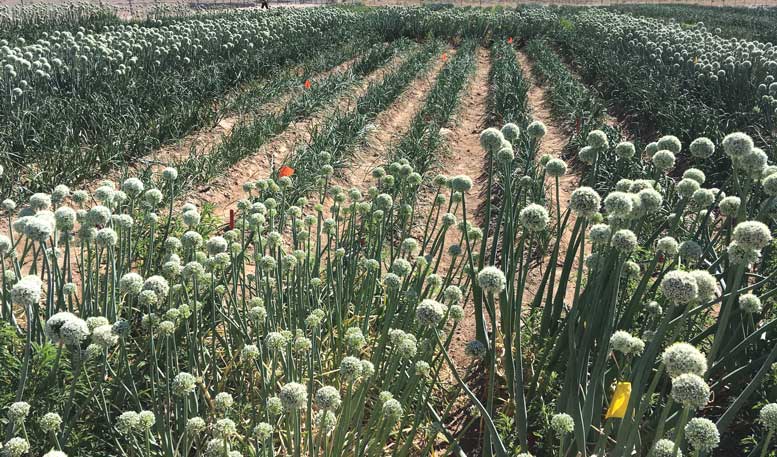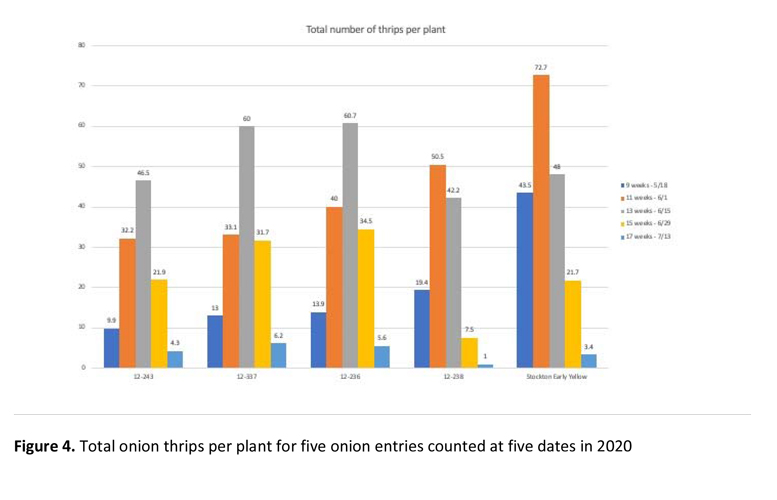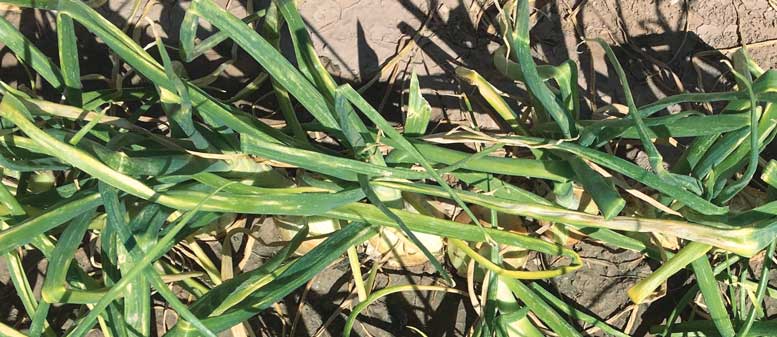By Chris Cramer and Ivette Guzmán, Department of Plant and Environmental Sciences, New Mexico State University
Iris yellow spot (IYS), caused by the Iris yellow spot virus (IYSV), appears as small necrotic, irregular or diamond-shaped, straw-colored lesions that are found on leaves and flowering scapes (Fig. 1). These lesions can grow in size and coalesce into larger lesions encompassing an entire leaf or girdle a scape that results in lodging.

IYSV is vectored mainly by onion thrips, the most important insect pest of onion in the U.S. Juvenile thrips acquire IYSV by feeding on infected tissue and transmit IYSV to healthy plants through adulthood. Both issues can cause reductions in bulb yield.
Onion thrips have shown a feeding preference for onions with waxy leaves. Therefore, onion cultivars with less wax on their leaves will often have fewer thrips. Currently, there are no cultivars upon which thrips do not feed and that do not express IYS when challenged with viruliferous thrips, IYSV and conducive disease-causing environmental conditions.

Research
Our breeding program at New Mexico State University (NMSU) has been working for 12 years to develop onion germplasm that develops fewer IYS symptoms when thrips and IYSV are present. Our most recent work is being funded by grant #2018-03407 from the SCRI, USDA NIFA program. The past two years, we have been evaluating NMSU onion germplasm that has less wax on the leaves, is less attractive to onion thrips and develops fewer IYS symptoms than onion cultivars with waxy foliage.
With our research, establishing the proper field layout for thrips and IYS evaluation is essential. Over the years, we have developed a field screening method that introduces viruliferous onion thrips to the evaluation field, promoting the spread of thrips and IYS throughout the field during the evaluation period. This method ensures that all onion plants being evaluated can be fed upon by thrips and can develop IYS symptoms.

Viruliferous thrip-infested bulbs from the previous year’s evaluation are placed around the edges of the field (Fig. 2). A short-day onion cultivar is autumn-sown on beds adjacent to beds containing planted onion bulbs. Transplants of the onion germplasm being evaluated are placed on beds in between the short-day onion beds.
Onion plants are rated for IYS on a scale of 0 to 4, where 0 = no symptoms; 1 = one to two small lesions per leaf; 2 = more than two medium-sized lesions; 3 = lesions coalescing on more than 25 percent of the leaf; 4 = more than 50 percent leaf death. The same 10 plants per plot are rated at four different times two weeks apart during the growing season.
Results
In 2020, four NMSU germplasm lines that had been selected for reduced IYS disease development were compared with Stockton Early Yellow, a cultivar with waxy leaves, for IYS disease development. At 11 weeks after transplanting, plants of Stockton Early Yellow had more severe disease symptoms than plants of the four other entries (Fig. 3). Two weeks later, IYS severity had increased for all entries; however, plants of Stockton Early Yellow still had more severe symptoms. At 15 and 17 weeks after transplanting, plants of NMSU 12-236, 12-243 and 12-337 had less severe IYS symptoms than plants of NMSU 12-238 and Stockton Early Yellow.
Some of the early differences in IYS disease severity between plants of Stockton Early Yellow and the four NMSU germplasm lines could be attributed to differences in thrips number per plant. At nine and 11 weeks after transplanting, plants of Stockton Early Yellow had a greater number of thrips than plants of other entries (Fig. 4).


A deficit irrigation treatment was placed upon plants to determine the effect of plant stress on IYS symptom development. By 17 weeks after transplanting, plants grown using the deficit irrigation treatment exhibited more severe IYS symptoms than plants grown using the normal irrigation treatment (Fig. 5).
From this work, several NMSU onion breeding lines show promise for reduced attractiveness to onion thrips and less severe IYS disease symptoms when conditions are conducive for both pest and disease issues.

